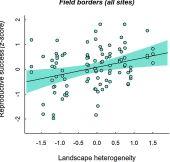
Humans like to do something. We go to war on cancer, we battle it, we seek to defeat it. We buy Tamiflu even though on even the most optimistic surveys of people who buy Tamiflu (and thus have white hat bias), it might knock off a few hours of symptoms. It's why placebos such as homeopathy, or useless herbal draughts of mysticism in naturopathy, are still being purchased. If people do something and a cold still ends in three days, at least they weren't bored.
When media-created claims about a "beepocalypse", manifested by a Colony Collapse Disorder, took environmental fundraising circles by storm, we all wanted to do something. Donors for doomsday groups rushed to solve the problem evil scientists had caused. Some threw up hives in their backyards (1), some sent more money so trial lawyers and lobbyists for groups like Union of Concerned Scientists, Center for Biological Diversity, and Natural Resources Defense Council could get seed treatments such as neonicotinoids (neonics) banned (2), and one company even started including seeds of invasive species in cereal they make for children.(3) Politicians wanted to show they could fix the problem even better than cereal companies, and began to advocate for more flowers in every nook and cranny available.
Bees are the apex of ecology. All our food is reliant on them, they began to claim.(4) Governments even began to give subsidies to farmers who implemented political beliefs about biodiversity, like planting flowers among their rows of food.
Did any of it work? Sort of. Since there was no beepocalypse, bees were never dying off(5), they can claim credit for the "rebound" and move on to coffee or Scott Pruitt or whatever is selling among the anti-science crowd who read The Guardian this month.
Scientific evidence takes a little while longer, and one thing that politicians advocated has been shown to be hype: filling in strips of land with flowers in order to keep bees alive and stop a foodpocalypse. A recent study using planted flower strips on farm land, the basis for doing it in cities, found that those flower strips actually reduced pollination of nearby plants. The scientists say that the increased flowers resulted in competition for pollinating insects. In cities, there are fewer bees, even if amateurs are throwing up hives on top of apartment buildings.
Farms have pastures and meadows, and those are better for bees and plants, including the food kind.
It's not that flowers are bad, but they should just say planting and maintaining them is a way to keep government employees busy and not pretend it is helping bees that aren't at risk.
NOTES:
(1) Ironically, this was a terrible idea, but if activists understood nature they'd accept more science. Bees die really easily, they are not in a Jerry Seinfeld movie and just rushing out into new places, they are confused and need to be manually fed. The amateurs who killed off bees with incompetence then claimed it must be pesticides.
(2) Which would weirdly mean a return to mass spraying, obviously worse for the environment.
(3) You, Cheerios.
(4) Only if your diet is almonds.
(5) Beyond the statistical blips - mass die-offs have been logged since the first domesticated hives were recorded, as far back as 950 AD. (detailed in Flemming G (1871) Animal plagues: Their history, nature and prevention. London: Chapman and Hall. 548 p.p.)
Citation: K.S. Andersson, Kathrin Seibel, Maj Rundlöf, Johan Ekroosa, Martin Stjernman, Ola Olsson, Henrik G. Smith, 'The impact of sown flower strips on plant reproductive success in Southern Sweden varies with landscape context' Agriculture, Ecosystems & Environment https://doi.org/10.1016/j.agee.2018.03.006



